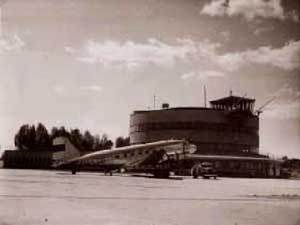History of Helsinki-Malmi Airport
 |
| A Ju-52 on floats in Katajanokka harbor. |
Regular air traffic from Helsinki began in 1924 to Tallinn and Stockholm using floatplanes operating from Katajanokka seaplane airport in the heart of the capital. In Scandinavian countries with their long stretches of seashore and countless lakes, floatplanes could be commercially operated longer than in central Europe, where they were being replaced by land-based aircraft. In the beginning of the 1930's, land-based commercial air traffic with regular schedules had established itself in central Europe to such a degree that building airports on land became a prerequisite for joining the European air traffic route network both in Sweden and in Finland. This was considered necessary for both international cooperation and trade.
 |
| The Lindberghs at Katajanokka, September 1933. |
The first land airport in Finland intended for civilian use, Artukainen Field in Turku, was completed in 1935, and only two years later there were already eight civilian airports in Finland. The location of Helsinki Airport was surveyed by, among others, the world-famous aviator Charles Lindbergh, who in September 1933, invited by Aero O/Y's managing director Gunnar Ståhle, flew to Finland in a specially equipped Lockheed Sirius with his wife Anne. The government committee searching for a location for Helsinki Airport supported the area in Tuomarinkylä recommended by Lindbergh and Ståhle, but out of housing-political reasons Helsinki City Council decided to locate the airport at Tattarisuo, a swampy area two kilometers east that was known to be extremely poor building ground. The City's argument was that "...the area of Tuomarinkylä must be considered much more valuable to housing purposes than Tattarisuo, where assumably no suburban settlement worth mention can arise."
 |
| The great hangar. |
Helsinki Airport with its shining white, perfectly round main building became operational in December 1936. The huge hangar could accommodate six Junkers 52 aircraft, and was at the time the second largest in Europe. The modern instrument landing equipment was also worth mention in the book "Helsinki Airport" (1938): "The blind landing apparatus at Helsinki land airport is of Telefunken construction and is uniquely built in such a manner that the homing beams cross each other, one being directed north, the other one west."
Helsinki Airport was officially inaugurated on 15 May 1938 in a ceremony that gathered a huge, proud audience of 25000 people from near and far. Among the 2000 invited guests were prime minister A.K. Cajander and marshal Mannerheim, who would lead the Finnish armed forces in the dark years looming ahead. In the spectacular opening airshow, the largest to date in Finland, a wide display of aircraft included the only autogiro in Scandinavia, and "A. Lunnela performed loops in a two-engined bomber" (Avro Anson). There were 1000 cars parked on the field, while the total number of cars in Helsinki at the time was about 6000.
 |
| Advertisement of Aero O/Y from the 1930's |
Aero O/Y, nowadays known as Finnair, could now move on to operating land-based aircraft. In 1939, the air route network in Finland already covered the major cities from Viborg in the south-east to Kemi in the north-west. The next year, the route network reached Petsamo in the far north. Many foreign airlines, e.g. ABA Swedish Airlines, Lufthansa and LOT, began regular traffic to Helsinki.
The rapid progress of Finnish civilian aviation was brutally interrupted by the Second World War. Helsinki Airport became a target of Soviet bombings and an important air base for the protection of the capital. Civilian traffic was temporarily transferred to other airports, and Finnish Air Force as well as units of the German Luftwaffe operated from Helsinki Airport until the end of the hostilities. Their excellent work was in part to thank for the minor damage caused by Soviet bombings to the capital and the Airport.
After the armistice in September 1944, Helsinki Airport was taken over by the Allied Monitoring Commission led by colonel general Zhdanov of the Soviet army. Until the end of 1946, civilian air traffic operated from the small Hyvinkää airfield.
 |
| DC-3 "Lokki" at Helsinki-Malmi Airport |
Towards the end of the 1940's, Helsinki Airport was getting inadequate for fulfilling the task of an international airport because of the fast pace of aircraft development. In August 1948, the runway broke under the weight of a DC-4 of Scandinavian Airlines. During the extremely cold period in January of the same year, another DC-4 had not experienced any problems, but the basic structural weakness of the former swamp was now making itself evident. Studies showed that the costs of lengthening the runways and making them stronger for big airliners were unacceptable. The time had come to build a new international airport. Helsinki-Vantaa International Airport became operational in 1952 just in time for Helsinki Olympic Games. Helsinki Airport, now known as Helsinki-Malmi, was assigned to serve the needs of light commercial traffic and general aviation.